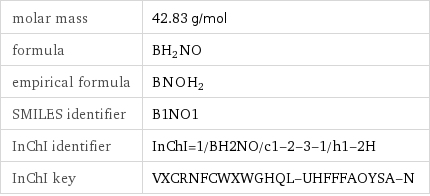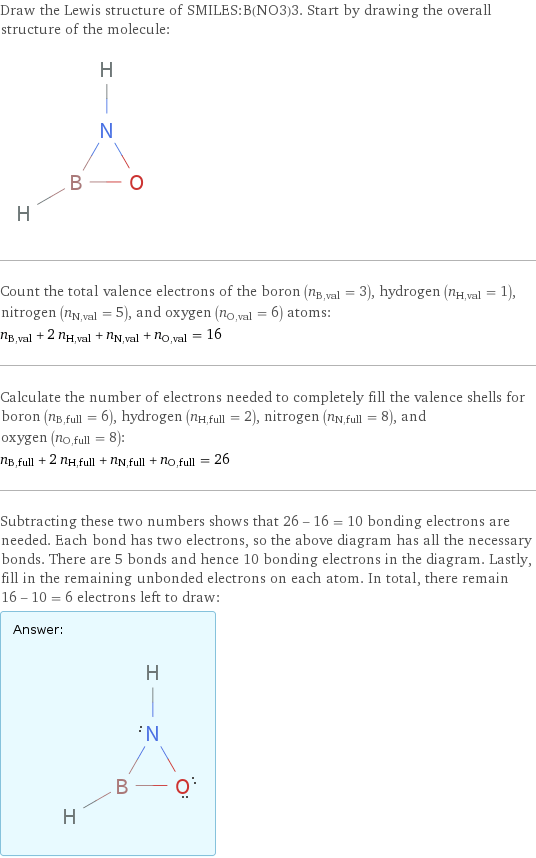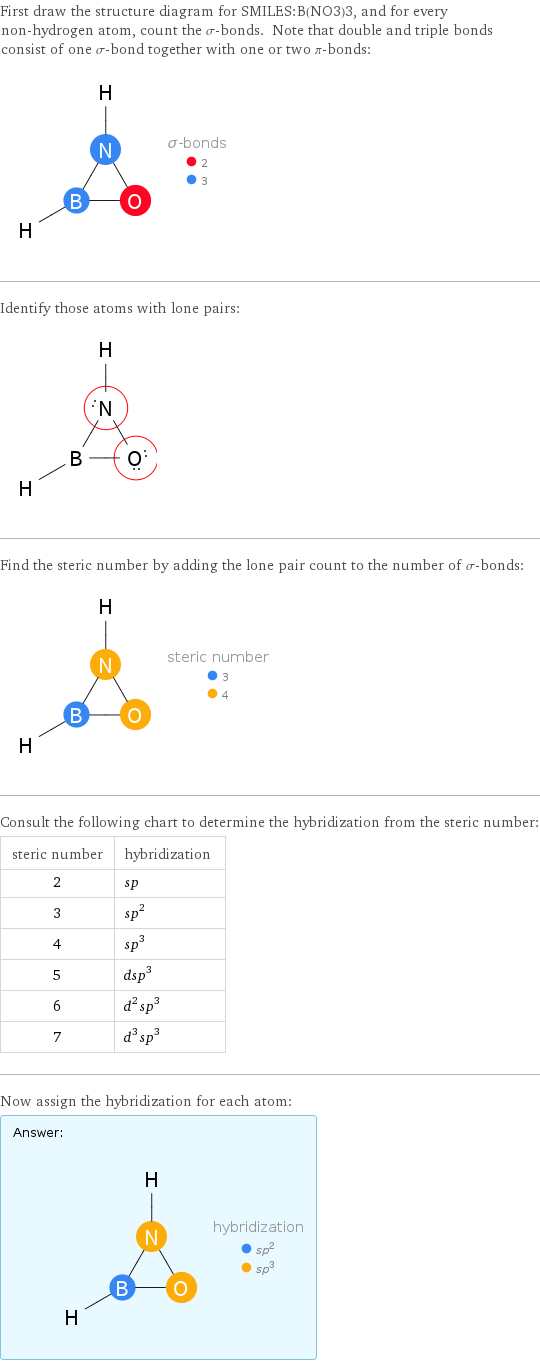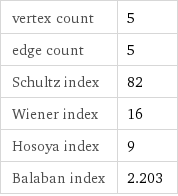Input interpretation

SMILES: B(NO3)3
Basic properties

molar mass | 42.83 g/mol formula | BH_2NO empirical formula | B_N_O_H_2 SMILES identifier | B1NO1 InChI identifier | InChI=1/BH2NO/c1-2-3-1/h1-2H InChI key | VXCRNFCWXWGHQL-UHFFFAOYSA-N
Lewis structure

Draw the Lewis structure of SMILES:B(NO3)3. Start by drawing the overall structure of the molecule: Count the total valence electrons of the boron (n_B, val = 3), hydrogen (n_H, val = 1), nitrogen (n_N, val = 5), and oxygen (n_O, val = 6) atoms: n_B, val + 2 n_H, val + n_N, val + n_O, val = 16 Calculate the number of electrons needed to completely fill the valence shells for boron (n_B, full = 6), hydrogen (n_H, full = 2), nitrogen (n_N, full = 8), and oxygen (n_O, full = 8): n_B, full + 2 n_H, full + n_N, full + n_O, full = 26 Subtracting these two numbers shows that 26 - 16 = 10 bonding electrons are needed. Each bond has two electrons, so the above diagram has all the necessary bonds. There are 5 bonds and hence 10 bonding electrons in the diagram. Lastly, fill in the remaining unbonded electrons on each atom. In total, there remain 16 - 10 = 6 electrons left to draw: Answer: | |
Quantitative molecular descriptors

longest chain length | 2 atoms longest straight chain length | 0 atoms longest aliphatic chain length | 0 atoms aromatic atom count | 0 atoms H-bond acceptor count | 0 atoms H-bond donor count | 1 atom
Elemental composition

Find the elemental composition for SMILES:B(NO3)3 in terms of the atom and mass percents: atom percent = N_i/N_total × 100% mass percent = (N_im_i)/m × 100% Plan: • Write the chemical formula and gather atomic masses from the periodic table. • Determine values for N_i, m_i, N_total and m using these items. • Finally, compute the percents and check the results. Write the chemical formula: BH_2NO Use the chemical formula to count the number of atoms, N_i, for each element and find the total number of atoms, N_total: | number of atoms B (boron) | 1 N (nitrogen) | 1 O (oxygen) | 1 H (hydrogen) | 2 N_total = 1 + 1 + 1 + 2 = 5 Divide each N_i by N_total to calculate atom fractions. Then use the property that atom fractions must sum to one to check the work: | number of atoms | atom fraction B (boron) | 1 | 1/5 N (nitrogen) | 1 | 1/5 O (oxygen) | 1 | 1/5 H (hydrogen) | 2 | 2/5 Check: 1/5 + 1/5 + 1/5 + 2/5 = 1 Compute atom percents using the atom fractions: | number of atoms | atom percent B (boron) | 1 | 1/5 × 100% = 20.0% N (nitrogen) | 1 | 1/5 × 100% = 20.0% O (oxygen) | 1 | 1/5 × 100% = 20.0% H (hydrogen) | 2 | 2/5 × 100% = 40.0% Look up the atomic mass, m_i, in unified atomic mass units, u, for each element in the periodic table: | number of atoms | atom percent | atomic mass/u B (boron) | 1 | 20.0% | 10.81 N (nitrogen) | 1 | 20.0% | 14.007 O (oxygen) | 1 | 20.0% | 15.999 H (hydrogen) | 2 | 40.0% | 1.008 Multiply N_i by m_i to compute the mass for each element. Then sum those values to compute the molecular mass, m: | number of atoms | atom percent | atomic mass/u | mass/u B (boron) | 1 | 20.0% | 10.81 | 1 × 10.81 = 10.81 N (nitrogen) | 1 | 20.0% | 14.007 | 1 × 14.007 = 14.007 O (oxygen) | 1 | 20.0% | 15.999 | 1 × 15.999 = 15.999 H (hydrogen) | 2 | 40.0% | 1.008 | 2 × 1.008 = 2.016 m = 10.81 u + 14.007 u + 15.999 u + 2.016 u = 42.832 u Divide the mass for each element by m to calculate mass fractions. Then use the property that mass fractions must sum to one to check the work: | number of atoms | atom percent | mass fraction B (boron) | 1 | 20.0% | 10.81/42.832 N (nitrogen) | 1 | 20.0% | 14.007/42.832 O (oxygen) | 1 | 20.0% | 15.999/42.832 H (hydrogen) | 2 | 40.0% | 2.016/42.832 Check: 10.81/42.832 + 14.007/42.832 + 15.999/42.832 + 2.016/42.832 = 1 Compute mass percents using the mass fractions: Answer: | | | number of atoms | atom percent | mass percent B (boron) | 1 | 20.0% | 10.81/42.832 × 100% = 25.24% N (nitrogen) | 1 | 20.0% | 14.007/42.832 × 100% = 32.70% O (oxygen) | 1 | 20.0% | 15.999/42.832 × 100% = 37.35% H (hydrogen) | 2 | 40.0% | 2.016/42.832 × 100% = 4.707%
Elemental oxidation states

The first step in finding the oxidation states (or oxidation numbers) in SMILES: B(NO3)3 is to draw the structure diagram. Next set every oxidation number equal to the atom's formal charge: There are 1 boron-hydrogen bond, 1 boron-nitrogen bond, 1 boron-oxygen bond, 1 nitrogen-hydrogen bond, and 1 nitrogen-oxygen bond in SMILES: B(NO3)3. For each of these bonds, assign the bonding electrons to the most electronegative element. First examine the boron-hydrogen bond: element | electronegativity (Pauling scale) | B | 2.04 | H | 2.20 | | | Since hydrogen is more electronegative than boron, the electrons in this bond will go to hydrogen. Decrease the oxidation number for hydrogen (by 1 for single bonds, 2 for double bonds, and 3 for triple bonds), and increase the oxidation number for boron accordingly: Next look at the boron-nitrogen bond: element | electronegativity (Pauling scale) | B | 2.04 | N | 3.04 | | | Since nitrogen is more electronegative than boron, the electrons in this bond will go to nitrogen: Next look at the boron-oxygen bond: element | electronegativity (Pauling scale) | B | 2.04 | O | 3.44 | | | Since oxygen is more electronegative than boron, the electrons in this bond will go to oxygen: Next look at the nitrogen-hydrogen bond: element | electronegativity (Pauling scale) | N | 3.04 | H | 2.20 | | | Since nitrogen is more electronegative than hydrogen, the electrons in this bond will go to nitrogen: Next look at the nitrogen-oxygen bond: element | electronegativity (Pauling scale) | N | 3.04 | O | 3.44 | | | Since oxygen is more electronegative than nitrogen, the electrons in this bond will go to oxygen: Now summarize the results: Answer: | | oxidation state | element | count -2 | O (oxygen) | 1 -1 | H (hydrogen) | 1 | N (nitrogen) | 1 +1 | H (hydrogen) | 1 +3 | B (boron) | 1
Orbital hybridization

First draw the structure diagram for SMILES:B(NO3)3, and for every non-hydrogen atom, count the σ-bonds. Note that double and triple bonds consist of one σ-bond together with one or two π-bonds: Identify those atoms with lone pairs: Find the steric number by adding the lone pair count to the number of σ-bonds: Consult the following chart to determine the hybridization from the steric number: steric number | hybridization 2 | sp 3 | sp^2 4 | sp^3 5 | dsp^3 6 | d^2sp^3 7 | d^3sp^3 Now assign the hybridization for each atom: Answer: | |
Topological indices

vertex count | 5 edge count | 5 Schultz index | 82 Wiener index | 16 Hosoya index | 9 Balaban index | 2.203